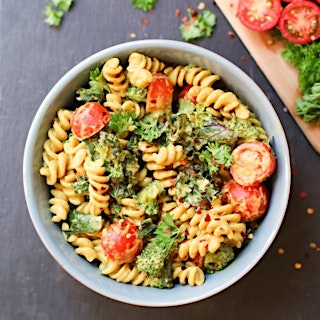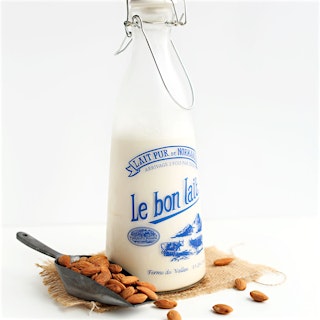Remove or Consume Less Dairy
- A diet free of dairy products leaves more room for foods that optimize health: fiber- and nutrient rich whole plant foods like fruits, veggies, whole grains, and legumes that help reduce chronic disease risk.
- Check in whenever you a) consciously avoid dairy products by making a check mark on the check-in screen, or b) consume dairy products by using a slip (aka free pass) on the check-in screen. If you realize you’ve made it the entire day without any dairy products, check-in by making a check mark at the end of the day.
What’s Inside
What’s IN
- Whole plant foods are always in! Make sure you’re getting plenty of nutrient-rich whole grains, beans, nuts, and seeds.
What’s OUT
- Avoid all dairy products, including those made from goat’s milk. Milk (any percent fat), dried or condensed milk, cream, butter, buttermilk, yogurt, cheese, and cream are out.
- Products with milk as a hidden ingredient are all over the grocery store. Even “nondairy” creamers usually have a dairy derivative (caseinate). Read labels carefully, and base your diet on whole plant foods – the ones without food labels.
- If you slip, no biggie. Slipping means you’re trying, which is what counts! You can get back on track for the rest of the day.
Why This Is A Good Idea
A diet free of dairy products leaves more room for foods that optimize health: fiber- and nutrient rich whole plant foods like fruits, veggies, whole grains, and legumes that help reduce chronic disease risk. Many people think that dairy is an important component of a healthful diet; it’s even considered its own food group. But humans have no biological need for the milk of another species. In facts, humans by design thrive best on foods rich in fiber and antioxidants, known to protect health – and dairy has neither. Dairy foods have been touted as a great calcium and protein source. Indeed they are, because calves depend on their mothers’ milk to gain 2 pounds every day for the first 4 months of life – about 40 times the growth rate of human infants! But that doesn’t mean that people should be joining in.
Cheese is the number one source of saturated fat in the standard American diet. The average American consumes over 33 pounds of cheese per year. The super-high levels of cholesterol and saturated fat in cheese (as well as other dairy products) have been shown to increase atherosclerosis and lead to cardiovascular problems. Cheese also contains potentially harmful hormones, as well as high levels of sodium. Cheese may trigger inflammation, leading to a slew of health problems. Furthermore, some research suggests that cheese contains addictive compounds.
Dairy products contribute heavily to carbon footprint. Ditching dairy reduces greenhouse gas emissions and helps protect marine ecosystems (dairy cows produce a lot of waste, much of which ends up in the rivers and oceans).
Basic Tips
- Check in whenever you a) consciously avoid dairy products by making a check mark on the check-in screen, or b) consume dairy products by using a slip (aka free pass) on the check-in screen. If you realize you’ve made it the entire day without any dairy products, check-in by making a check mark at the end of the day.
- Be experimental, and keep an open mind. Your new way of eating is a delicious adventure, not a punishment.
- If you’re used to eating yogurt as a source of probiotics, don’t worry – there are several nondairy sources of probiotics. The most obvious is plant-based yogurt, but you can also depend on sauerkraut, kimchi, pickled vegetables, kombucha, tempeh, and miso. Read more about plant-based probiotics here.
- In baking and cooking, most dairy products can be substituted with plant-based alternatives. Be mindful of flavors (e.g. you wouldn’t want to use vanilla almond milk in a creamy pasta sauce).
Shopping List
- The most obvious place to start is next to the dairy section, where the “plant milks” are stocked. Try one or two at a time until you discover what you like. Oat and almond milks are mild-flavored and versatile. Soy milk is the highest in protein and is available in regular or low fat. Coconut beverages taste strongly of coconut. When possible, choose unsweetened and calcium fortified plant milks.
- Buy raw almonds, cashews, and/or flax seeds to make your own plant “milk.”
- Beware of plant-based cheeses; some have dairy derivatives. Look for “vegan” or “100% plant based” on the label.
- Plant-based yogurts often have a lot of added sugar. Choose an unsweetened variety and add your own fresh fruit.
- Worried about calcium? Stock up on nature’s richest sources of calcium from plants: leafy greens like kale, swiss chard, spinach, and broccoli, beans, seeds, nuts, and tofu.
- Swap out butter for plant based spreads that are low in saturated fat and have a good amount of omega-3 fats.
- Daiya vegan cheese is a staple for those quesadilla fans out there (yes, it melts!). For a more whole-foods, nutrient dense cheese, raw cashews are a perfect base.
Recipes
Veggie Mac ‘N Cheese by NutritionFacts.org 
Cashew Cheese by The Full Helping 
Almond Milk by Minimalist Baker 
Smart Things To Read And Watch
- The Last Conversation You’ll Ever Need to Have About Eating Right
- My Milk Manifesto
- Vegan Substitutions Guide by Veg Kitchen
- 18 foods you think are dairy-free but aren’t
Note: Diet ID is not focused on the number on the scale. Weight loss can be a byproduct of developing healthier eating habits, but if you have questions about your weight, please contact your physician.